The Biological Species of Ancient and Modern Wheats
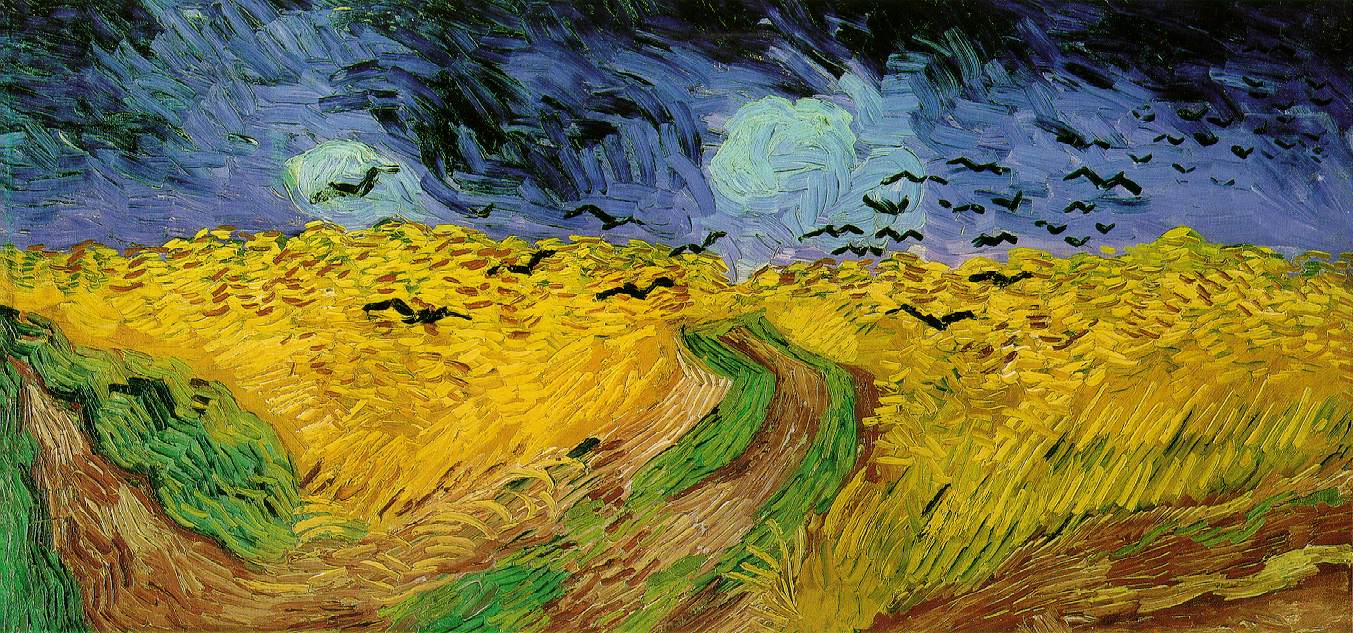
In the first part of this series about heirloom/heritage, ancient, and landrace grains, we discussed the terminology we use to describe these grains. In this article, we will address the biological dimension of these grains’ evolution and characteristics.
You may have heard of different sorts of wheat flours, whether these are made out of soft/hard, and red/white wheat. Bread bakers readily get their flours from the marketplace – they buy flours labelled as “bread flour” –, but not all bread flours are made equal. Understanding the specifics of grain classification, particularly that of wheat, will help you make better choices, and will allow you to better explain the differences to your customers.
Wheat is a grass
Humans have fed on plants, fruits, and animals for thousands of years. Wild plants have been part of its diet long before the agricultural revolution. The grains are the vehicule for the reproduction of these grasses. They contain the genes, the nutrients, and the energy to fuel the grain’s growth into a new generation of plants. And these plants will again produce grains, which will turn into seeds, and the cycle continues on.
When hunter gatherers progressively managed to sow, grow, and harvest the grains of some of these wild plants, they picked the sorts that were already thriving on their own, without any human intervention. Slowly, the selection of grains for some of their qualities, properties, and functionalities gave rise to new species of grains. Domesticating grains and wheats have been the cornerstone of civilizations thousands of years ago, and recently, too.
In the 21st century, not only have these selections become very complex, they are also acccompanied by research at the genetical, biological, and ecological levels.
The families, tribes, and species of grains
In terms of grass classification, we make use of biological taxonomies which include: family, subfamily, tribe, species, and subspecies. These taxonomies serve to classify grasses and grains appropriately. This classification largely depends on the genetical characteristics of grains and wheats.
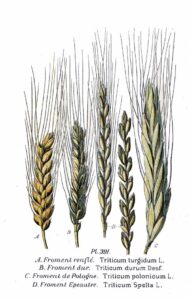
The grass family itself, and as a whole, is called Poaceae in Latin.
The subfamily which mostly interests us for its bread-making quality is called Pooideae – whereas other subfamilies include other grains such as corn, millet, rice, etc.
From there, we move into the Triticeae tribe, which contains the many species of bread-making quality grains we’re most familiar with. That’s why all these grains are named first by mentioning their tribe name, “Triticum.”
The grain species that are part of the Triticeae tribe include:
- Bread wheat (Triticum aestivum)
- Einkorn (Triticum monococcum)
- Emmer (Triticum dicoccum)
- Spelt (Triticum spelta)
- Durum (Triticum durum)
- Khorasan (Triticum turanicum)
- Rye (Secale cereale)
- Barley (Hordeum vulgare)
The only Triticeae grain that doesn’t have any bread-making quality is barley – and rye, depending on whether you’re a rye adept or not.
Barley is included in this tribe because it has evolved alongside its cousins (particularly einkorn and emmer) for thousands of years, both in the wild, and during the early stages of agriculture.
In a general sense, all Triticum species are wheats. Therefore, we have wheats, barley, and rye as part of a large tribe in which many characteristics are shared.
Hard/soft, red/white wheats are all Triticum aestivum
Bread wheat (Triticum aestivum) is further classified into soft/hard, and white/red categories. And to further complexify things, wheat can be either “spring” or “winter,” depending on when it is sown.
Let’s have a closer look at those wheats which are of interest for bread bakers.
Hard red/white winter wheat
Wheat that is sown in fall is called “winter wheat” because the seed germinates right before the ground freezes. The sprouted grain will resume its growth when the weather heats up again in spring, and the grains will be ready for harvesting in July-August. This is the sort of wheat that’s grown in locations which have gentle to quite intense winters (such as Northern Texas, eastern Colorado, Nebraska, and Kansas – and Canada, including colder regions of Quebec).
Hard red spring wheat
Wheat that is sown in spring is called “spring wheat.” It’s sown in spring, in locations with a long summer, a warmer and dryer weather, or where winters are very cold. The grains are ready for harvesting later in the following fall, in September-October. Places like Dakota, Minnesota, Montana, Alberta, Saskatchewan, and Manitoba are the home of spring wheat. In Quebec, for instance, you’ll find both both spring and winter wheats.
Hard white wheat
Hard white wheat does not possess the gene that gives red wheat its particular color, and its organoleptic profile. As Jeffrey Hamelman writes in Bread, the bran of white wheat is, yes, you’ve guessed it, white. So when we mill whole white wheat, we obtain a flour that’s whiter than a bolted or sifted flour made with red wheat, which we’d usually call “white (unbleached) flour.” So the two types of flours that result from different wheats are not to be confused!
Hard white wheat is popular is China, where it is used to make noodles. For the purpose of bread making, red wheats are commonly the norm.
Globally, there are more than 20,000 known varieties of T. aestivum. Each year, agronomists, seed breeders, and farmers create new varieties either out of their labs or of their fields.
Durum wheat
Italians have developed many recipes to make bread out of durum wheat, but the main use of this sort of wheat is in pasta production. It contains high levels of protein.
Wheat gluten strength vs. quality
Spring wheats have higher levels of protein than winter wheats (13-15% vs. 11-12%), and are preferred to make bread industrially. The gluten network can be developed to a very strong degree, and the dough can stand the heavy manipulations through machinery. However, dough made with strong gluten may not hold very long when the gluten network starts to desintegrate through the actions of enzymes. It can also break down under intense mixing conditions.
In artisanal, craft baking, winter wheats show a higher quality of gluten. While the gluten network is less strong in winter wheat, it accomodates for better hand manipulation (mixing, shaping), and for long fermentations that progressively destroy the gluten network. With a better gluten quality (rather than strength) dough can be bulk fermented or proofed over long periods of time, and be baked as free standing hearth loaves.
Einkorn
The German root of the word “einkorn” refers to “one grain,” that is the one grain that grows per spikelet. There are 3 subspecies of Triticum monococcum, a wild variety (T. monococcum subsp monococcum), a domesticated one (T. monococcum subsp boeoticum), and T. urartu, from which T. aestivum has inherited part of the genome. In other words, bread wheat has some of its origins in einkorn.
Einkorn originated in the Fertile Croissant and Caucasus. It was domesticated 10,000 years ago. It is currently grown in Western Europe, and its yield is way lesser than that of bread wheat.

Emmer
Emmer (T. turgidum) was the most “popular” wheat 10,000 to 4,000 years ago. It was cultivated to make flat breads and most probably beer. In 19th century France, it was used to make bread. Currently, it is grown sporadically in Eastern Europe, the Middle East, India, and Ethiopia.
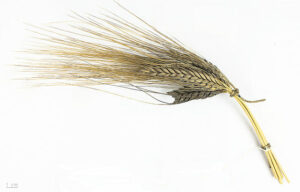
Spelt
Spelt (T. spelta) has a genome that’s closer to bread wheat (T. aestivum) than, say, emmer or einkorn. Archeologists have found spelt grains in exacavations dating from the 6th century BCE. It grows in areas that are not so fertile, in Germany, France, Belgium, and Switzerland.
Einkorn, emmer and spelt all have their grains covered with a hull. So, dehulling them adds an extra cost and time. These grains are not so popular among large-scale farmers, and because of these extra operations, they sell at a much higher price.
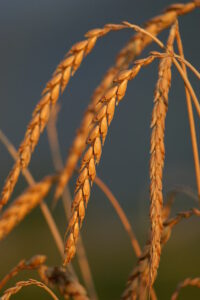
Khorasan
Khorasan (T. turanicum) is the name of a province in Iran, where the specie originated. The grain has been trademarked as Kamut (supposedly “wheat” in Egyptian) in the United States. It has been grown for the last 40 years, mostly through organic agriculture. Khorasan is similar to durum wheat, contains high levels of proteins (but poor gluten quality), but its grains are much bigger.
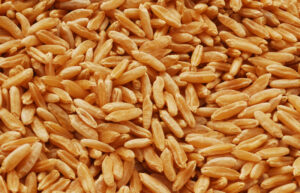
Rye
Rye (Secale cereale) has been used traditionally in many bread-making cultures, including Spain, France, and Germany. Rye contains the proteins need to build gluten (gliadin and glutenin), but because it contains pentosans the gluten network doesn’t develop at all. That’s why it’s tough to make bread with rye flour!
To add up to the challenge, rye contains lots of enzymatic activity. Many bread bakers keep a rye starter, because such a starter will remain very active under difficult conditions. Bread bakers must use acidic and lactic sourdough fermentations to control for the deterioration of starches under enzymatic activity. If you’re into rye bread, the ultimate reference is The Rye Baker, by Stanley Ginsberg.

Further study
The Dictionnaire universel du pain is also a complete reference which includes articles on the biology and genetics of grains (great if you can read French.
The book Modernist Bread by Nathan Myhrvold and Francisco Migoya covers grains, from biology to agriculture.